Interview with Andreas Hykade (‘Altötting’)
UPDATE: Altötting is now available to watch in full (below) via the Filmbilder & Friends YouTube channel
Among the most talked-about short film highlights at this year’s edition of the Annecy International Animation Festival was Andreas Hykade‘s Altötting, a “coming-of-age story about love, faith, mortality, and shattered illusions”.
A co-production between Studio Film Bilder, Ciclope and the National Film Board of Canada, the director’s first film since 2014’s Nuggets (outside of the ongoing TOM series) simultaneously evokes the effective simplicity and rich complexity of much of his earlier work, including the passionately detailed character work of Ring of Fire (2000), the understated pathos of The Runt (2006) and the hypnotically stark interplay of line and colour in Love & Theft (2010).
Having drawn upon autobiographical elements in his previous work (such as the ‘Country Trilogy’ that groups Ring of Fire and The Runt together with his 1995 Filmakademie Baden-Württemberg student short We Lived in Grass), Altötting draws upon Hykade’s childhood remembrances of a devotion to the Virgin Mary and its emotional, artistic, architectural and geographical associations with it. Bringing on the distinct talents of fellow director Regina Pessoa, the film boasts some of the richest and most engaging visual sequences in Hykade’s work thus far, married with poignant introspection and philosophical musings on the crucial roles religion, time and place play during our formative years.
During the film’s involvement at Annecy and ahead of its upcoming screenings at Animafest Zagreb we spoke with Andreas to learn more about the the origins of Altötting and the particular relevance it holds to him as a filmmaker.
When last we spoke your most recent short film project was 2014’s Nuggets. Did this film begin production after that or, given the subject matter, do its origins go further back?
The origins of the film Altötting go further back. I grew up as a devoted disciple of the Virgin Mary. It was a personal choice—nothing that was forced upon me. Then I slowly progressed toward being a secular person. This meant losing the Catholic Church, the Pope, the Bible, God, Jesus and, finally, the Virgin Mary. It was a process that would take me 30 years. Then it took me another five years to craft the film. So, yes, it goes way back. From my point of view, every work of substance has to go way back.
Does this film mark your first time collaborating with the NFB? What brought you and them together for this project?
Yes, it was my first collaboration with the NFB, although I have to confess that I’ve dreamed of working with the NFB since I was a student. I wanted the whole grand Canadian animation tradition to rub off on my work. The collaboration started when I met [NFB producer] Marc Bertrand at the Zagreb Animation Festival. We talked about the Virgin Mary. I found out that Quebec and Montreal are Virgin Mary places as well. So there was a natural connection through the content. Working with the NFB was and is a wonderful experience for me. The whole operation is always centred around the content and the heart of the project.
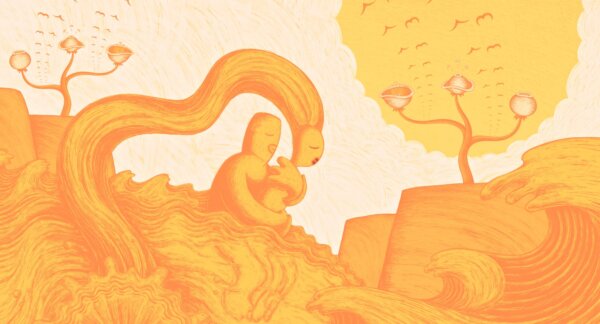
Altötting (Dir. Andreas Hykade, ©2020 Studio FILM BILDER, National Film Board of Canada, Ciclope Filmes)
As an overall co-production, how does the dynamic/division of labour work between Studio Film Bilder, Ciclope and the NFB (and your working relationships with Thomas, Abi and Marc respectively)? Do each focus on separate areas of production, for example?
Yes, each one focusses on specific areas of production. Film Bilder and Thomas Meyer-Hermann secured the German financing. The whole film was developed and animated in Germany. Ciclope Films in Portugal took care of the “Virgin Mary” design of the film. These parts of the film were executed by Regina Pessoa and her team. The NFB took care of all the sound and the music, which were essential to the film. They also put effort into the preparation and post-production, so now it seems to me that the result was the best of all worlds. It’s a true German-Canadian-Portuguese co-production. It’s an example that proves co-productions can be art-driven instead of money-driven. I’m happy about this.
As your narrator’s outlook and relationship with the Virgin Mary evolves it seems the overall approach to the design and animation does likewise. Was there much by way of experimentation when it came to the visual development and the changing aesthetic of the film or was that always how you pictured it?
Regina Pessoa first provided four key drawings for the project and I was able to develop the whole project based on these drawings. I’m German, so everything was very well planned and we didn’t create even one extra frame. We only produced what we needed. During the production, there were about a thousand little details for thousands of drawings, but Regina is an extraordinary artist, so she always made the right decisions. I suppose it was painful for her and her team, but she made it really painless for me. I could not be more thankful.
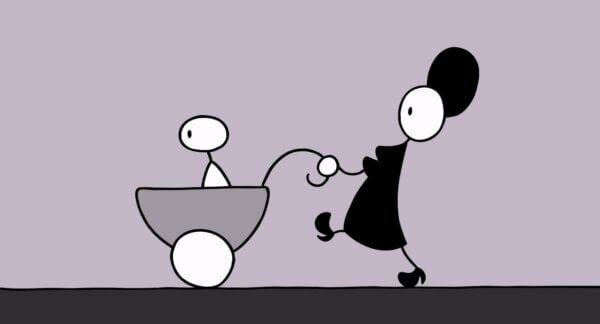
Altötting (Dir. Andreas Hykade, ©2020 Studio FILM BILDER, National Film Board of Canada, Ciclope Filmes)
A superficial reading of the film could be that your relationship with religion is analogous to a young man’s infatuation that he has moved on from, although the variety and depth of images it conjures suggests something more substantial. Assuming there is an autobiographical component to Altötting, do you still have ambivalences regarding the subject of religion, or residual connections to it, that the film might be reflective of?
Well, I hope the film speaks for itself. I also hope it leaves enough space for the audience to bring their own experiences to it. So I don’t want my interpretation of the film to overshadow it; I want to leave it to the audience. One thing I can say: I don’t believe in God and the afterlife anymore. But I see religion as part of the history of humankind. We are what we are partly because of religion. Now I think we should bring the power of religion into the secular world.
While the quality of movement and performance is very high-end throughout, the relative simplicity of form and fluidity of motion in the film’s opening sequence suggests a different approach has been taken to the character animation than in later scenes, was this the case?
Well, the whole thing had to make some overall sense. This entailed starting very simply, perhaps primitively, in the “real” world. Then, to show the power and the beauty of religion, we had to become more elaborate in the “Virgin Mary” parts. Then, when religion sets our hero on fire, we had to dive into this beauty, become overwhelming. Then, at the finale, we had to turn this beauty into darkness. In the end we go back to a certain kind of simplicity, but with a touch of light. A touch of Virgin Mary-spook. The sound and the music do the rest and turn it into a kind of ghost story in the end.
Following on from that, are you able to break down the animation pipeline/softwares etc to achieve the visual result you desired?
No.
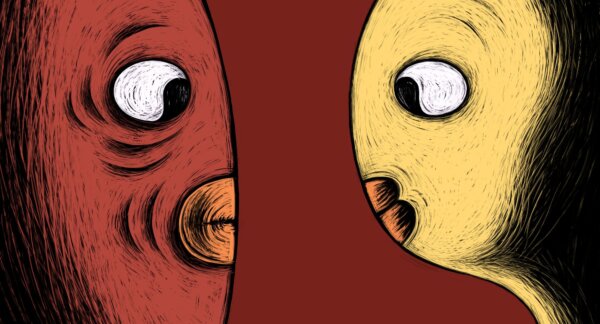
Altötting (Dir. Andreas Hykade, ©2020 Studio FILM BILDER, National Film Board of Canada, Ciclope Filmes)
One thing that definitely shines through is the influence of Regina Pessoa to the visuals, is it safe to assume that you’re a fan of her prior work?
I’m more than just a fan. Regina’s work had a huge influence on my work, in a weird way. I saw her debut, The Night, in 2000, the same year that my film Ring of Fire came out. Both films had these “scratchy” elements, only her scratches were full of life, while mine were just stiff. So I thought: I’ll leave the whole scratching thing up to her, because she is obviously the queen of scratch. So I turned to simple stick-figure-with-flat-colours kind of stuff, but 15 years or so later I needed that scratchy element. So I phoned up Regina and asked her if she wanted to support my film. Not only did she agree, but she also got her partner Abi Feijo on board, who secured the Portuguese portion of the funding. So Regina could work with her team in Portugal. And I had the pleasure of visiting the studio and Regina and Abi and spending some time in their garden of Eden. I became friends with their rooster and baptized him Charles.
Was she always in mind as someone you wanted to collaborate on for this film or did the idea of the two of you joining forces come later on?
I always had her in mind. The whole thing would have turned into some terrible rip-off if she hadn’t joined in.
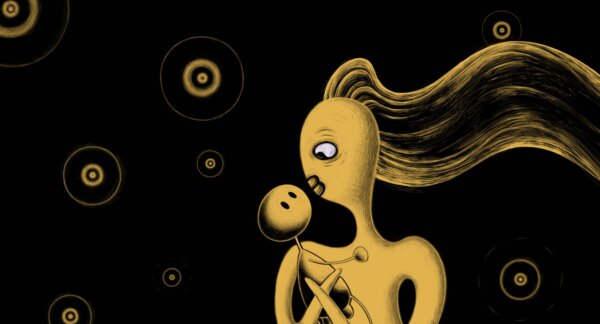
Altötting (Dir. Andreas Hykade, ©2020 Studio FILM BILDER, National Film Board of Canada, Ciclope Filmes)
Cosmetically her presence can definitely be felt from the signature approach to the shading and lighting, were there any other artistic sensibilities or approaches her involvement brought to the table that the film particularly benefited from?
Yes. There were some crucial moments when it was about defining the specifics of the narrative. The specifics of the narrator. I always included Regina, discussed these issues with her and followed her direction. I trusted her. She kept reminding me that the film is a love story. And because I trusted her, I wanted to satisfy her. I didn’t want an artist like her to devote so much time and in the end not be satisfied with the result. So I wanted her to like the film. I hope she does.
Have you learned anything from this collaboration that you think you might apply to your future work?
I can only hope that I’m a learning system. What did I learn with this project? To trust in the art. To accept the art. To go all the way with the art. To find an intense process. To find the best people one can find for the project. To stay on the road of art even when it gets rocky. What did I learn from the collaboration with Regina? To accept kindness.
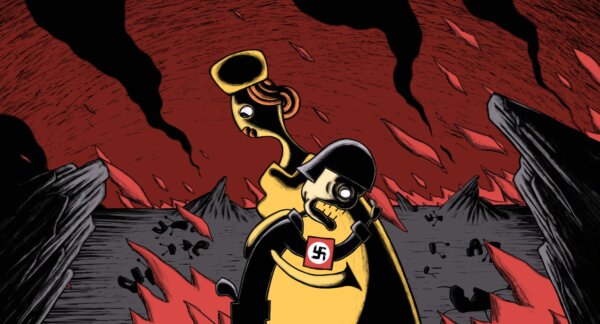
Altötting (Dir. Andreas Hykade, ©2020 Studio FILM BILDER, National Film Board of Canada, Ciclope Filmes)
A particularly striking sequence in the film is oriented around death in the arms of the Virgin Mary. Can you elaborate on the significance of this visual and the role it plays in you/your narrator’s story?
You see, when you talk about the subject of religion you come to a kind of mystic component—something that cannot be explained with words. The part you’re referring to is the mystic component. It’s the part where the visuals take over. Hopefully the mind of the audience takes over as well.
The team of animators seem to have worked well together to create a very consistent piece, can you talk a bit about how you communicated with them as a director and fellow animator to achieve this?
I do a very detailed X-sheet. Every frame is defined. Every hair is numbered. It’s like writing a sheet of music and finding the best musicians to execute it.
The film suggests certain locations and artworks – the chapel with its votive offerings, for instance – held special significance to you at a crucial time. Is this still the case, and has making the film had any effect on your connection to them?
This chapel in Altötting, with its thousand drawings created by devotees over hundreds of years, was my doorway to the spiritual world and to the past when I was a boy (this was the seventies). It was also some kind of prequel to the Internet for me. Remember, this was before Star Wars. So, yes, it had huge relevance for me when I was a boy. Now I visit the place like someone who’s visiting the grave of a long-lost lover.
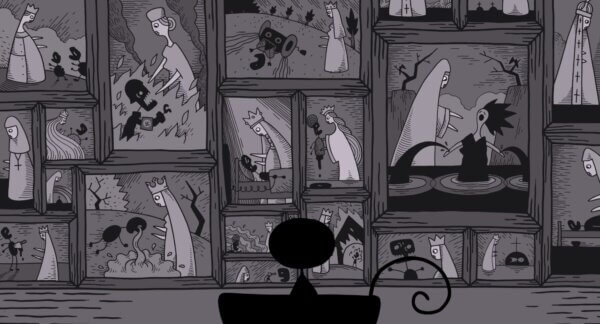
Altötting (Dir. Andreas Hykade, ©2020 Studio FILM BILDER, National Film Board of Canada, Ciclope Filmes)
I’ve been following some other work you’ve done of late, including TOM for younger audiences, graphic novel illustration; you also teach, of course. Do you find these types of projects require a different artistic headspace to each other, and does your work any of them inform or influence one another?
I think everything influences everything. But each thing is different as well. With my personal artistic work, I try to have complete control. The dark stuff needs a dark mind. The light and funny stuff is there to bring light into my world. With the students, it’s more like being a servant who brings some knowledge of the past. I try to ask the right questions at the right time to provide a basis for the students, so their ideas can come to full bloom.
Has making/finishing this film had any direct influence on what project you will be tackling next (or are working on presently)?
There are a few ideas laying around but I haven’t picked one yet. There are three seconds in Altötting when the Virgin Mary comforts a Nazi. This could be the door to the next project, as my family history is connected with this Nazi. We’ll see. The future is unwritten.
Following its recent inclusion at Annecy, Altötting will screen in competition at Animafest Zagreb in September. Learn more about Andreas Hykade’s work in episode 6 of Intimate Animation Season 1


